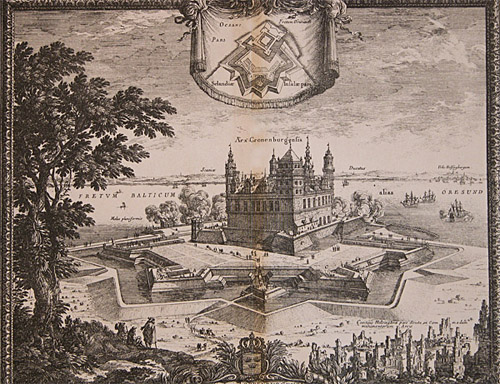| Helsingør og Kronborg

| | Karl Gustav-krigene gik hårdt udover byen. Og svenskernes bombardement af Kronborg, hvor bl.a. sydtårnet gik til, betød at man lagde planer for en omfattende udbygning af fæstningsanlæggene rundt om slottet.
Forslagene om en genopførelse af sydtårnet er, underligt nok, aldrig blevet realiseret.
Svenskeren Erik Dahlberg gav allerede under krigen et forslagt til dette. |
Helsingør i krigens skygge
For Helsingørs vedkommende kulminerer krigsbegivenhederne ved Karl Gustavkrigene med byens belejring og Kronborgs erobring i 1658. De samlede omkostninger, eller om man vil tab, ved belejringen opgøres af byens borgere til 500.000 rigsdaler. Efter fredslutningen med Sverige i 1660 forøges byens indbyggertal med tilflyttende skåninger, hidlokket med tilbud om skattefrihed i 25 år og i 1675 består byen af 833 familier inddelt efter 10 skatteklasser.
Bysamfundene på Sjællandssiden er tilsyneladende dybt forarmede efter Skånske Krig. I Helsingør øges skattetrykket i de efterfølgende år på grund af fraflytning, og det angives, at der i året 1688 er flere hundrede ledige gårde og huse og at familiernes antal er formindsket fra 800 til 300. Fra slutningen af 1680erne lettes skattebyrden på forskellig vis og i 1690 bliver byen fritaget for at betale grundskat i 10 år med henblik på at bringe den på fode igen og 32 navngivne embedsmænd og borgere fritages for skattebetaling.
Omkring århundredeskiftet er der stadigvæk store problemer med tomme huse og fraflytning og der berettes, at medlemmer af færgelauget tager hyre på fremmede skibe. Selv ejede byen ikke et skib til udenlandsfart, kun 12 mindre fartøjer til indenlands sejlads, men måtte årligt svare omkring 20.000 rigsdaler i skatter og afgifter og som minimum sørge for 720 mands indkvartering.
Kronborgs befæstning
Allerede efter fredsslutningen i 1660 syslede man med planer om at forstærke fæstningsværkerne omkring Kronborg. Det var åbenbart at fæstningen ikke havde stået distancen under den svenske belejring. Det store sydtårn var blevet skudt ned og i det hele taget lå slottet alt for tæt på byen, således at svenskerne fra selve bymuren og de tilstødende kvarterer kunne beskyde Kronborg direkte.
Sydtårnet blev skudt ned og aldrig rekonstrueret i sin opringdelige form. Det sønderskudte kvarter af byen, som lå op til Kronborg blev heller aldrig genopført, hvilket på længere sigt gav mulighed for udbygning af fæstningsanlægget og anlæggelse af en egentlig havn.

Kronborg før bombardementet | 
Kronborg bliver en grænsefæstning | 
Kronborg 1660 | 
Helsingør i fugleperspektiv |
Kroneværket
Fra 1663 stammer en plan af Kronborgs befæstning, der angiver en forstærkning, som tilsyneladende indbefatter den tidligere slotshavn og en bedre afrunding ned imod stranden. Det er dog først efter Skånske Krig i året 1688 man for alvor begynder at iværksætte den udvidede befæstningsplan. Arbejdets ledelse overdrages Dominicus Pell, der blev indkvarteret i Helsingør "tillige med 30 heste og disses oppassere, 26 murersvende, 1 skibsbygmester med svende samt 5 underofficerer 1 tambour og 70 mand af livgarden".
Den ydre befæstning der fuldendes i løbet af 1690erne fik navnet Kroneværket og over Kroneværksporten findes en samtidig indskrift forfattet af Thomas Kingo:
Trin ind, om Du est værd, jeg lader op min Bue
Og åbner Pladsen til det Cronet Slot at skue,
Tre Konger der har ført af Vand, af Ild, af Skud,
Trods Havets Svælg, trods Brand, trods Fjendens Kugle-Brudd!
Nu har Kong CHRISTIAN den Femtes Magt og Møje
Ret Kronet Værket, trods den avindsyges Øje,
GUD give Kongen og hans Slægt en evig Rod,
Så længe Øresund skal kysse Kronborgs Fod.

Kronborg med udvidet befæstning, 1663 | 
Kroneværksporten | 
Udbygningsplan for Kronborg, 1700 | 
Udbygningsplan 1730 |
Fortsat udvidelse
Et kort over byen fra 1697-98 viser, at arbejdet endnu ikke er helt fuldendt på dette tidspunkt. Fæstningsværkerne udvides under Frederik 4.., hvor forværkerne i 1713 omdannes til raveliner i tidens ånd. Kroneværksporten udbygges omkring 1730 og det samlede anlæg er fuldt udbygget omkring 1740. På det tidspunkt har Danmark og Sverige været igennem endnu en indbyrdes krig, som hovedsagelig foregår i Skåne. Kronborg, der nu markerer landegrænsen, fremstår nu som en kaserne med fast garnison og byen Helsingør nu også som garnisonsby. |